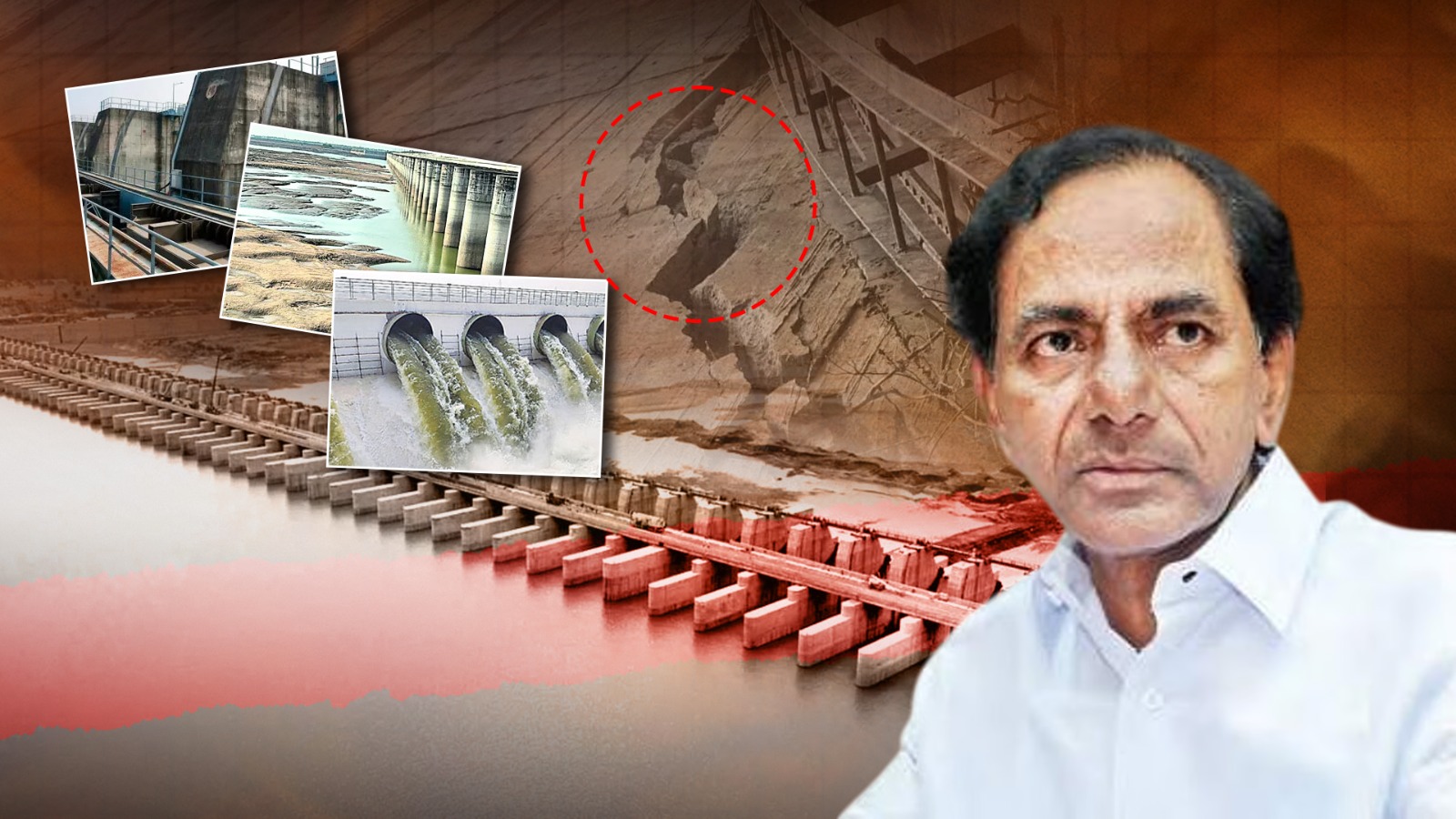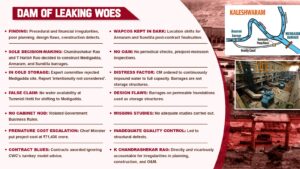The report revealed a litany of governance failures, accusing key figures of suppressing expert advice, bypassing protocols and causing colossal public expenditure, resulting in the current distress of the barrages.
Published Aug 04, 2025 | 12:35 PM ⚊ Updated Aug 04, 2025 | 4:47 PM

Kaleshwaram project irregularities.
Synopsis: The Justice PC Ghose Commission held former chief minister K Chandrashekar Rao, former irrigation minister T Harish Rao, and several top officials directly accountable for the defects in three barrages of the Kaleshwaram Lift Irrigation Scheme. The commission flagged rampant procedural and financial irregularities, design flaws, and construction defects.
The Justice PC Ghose Commission held former Telangana chief minister K Chandrashekar Rao, former irrigation minister T Harish Rao, and several top officials directly accountable for the collapse of the piers of the Medigadda barrage and structural defects in Annaram and Sundilla barrages.
The Commission, probing the alleged irregularities that took place in the construction of the Kaleshwaram Lift Irrigation Scheme (KLIS), submitted the report to the state government.
The state Cabinet, which is meeting on Monday, 4 August, is expected to discuss the report and finalise further course of action on it.
According to the executive summary of the report, the commission has flagged rampant procedural and financial irregularities, design flaws, and construction defects in the three barrages.
The report revealed a litany of governance failures, accusing key figures of suppressing expert advice, bypassing protocols and causing colossal public expenditure, resulting in the current distress of the barrages.

The report at a glance.
The Commission’s findings detail a project marred by poor planning, questionable contract awards and a complete absence of operation and maintenance (O&M), transforming the Kaleshwaram Project — intended as Telangana’s lifeline — into a monumental financial and structural debacle.
The report estimated the project’s cost, initially pegged at ₹38,500 crore, went up to over ₹1,10,248.48 crore by March 2022, with allegations of funds being siphoned off to favour contractors.
The inquiry found that the decision to construct barrages at Medigadda, Annaram, and Sundilla was the “sole and individual decision” of Chandrashekar Rao and Harish Rao, without formal government approval or Cabinet sanction, violating Government Business Rules.
An Expert Committee, formed under Government Order (GO) No. 28 on 21 January 2015, had rejected the Medigadda barrage site due to its “prohibitive cost and time consumption,” recommending alternatives like Venanappaly.
This report was deliberately suppressed by Chandrashekar Rao and Harish Rao, kept “in cold storage,” and ignored, the Commission said.
The justification for shifting the barrage site from Tummidi Hetti to Medigadda, citing “no availability of water,” was deemed “insincere and dishonest” by the Commission.
Besides, the initial administrative approvals (GOs numbered 231, 232, and 233, dated 1 March 2016) bypassed Cabinet scrutiny, and a letter from Chandrashekar Rao to the Prime Minister on 11 February 2016 cited a project cost of ₹71,436 crore before the final Detailed Project Report (DPR) by WAPCOS Limited was submitted.
The Commission criticised the awarding of contracts on a “lump sum” basis rather than the Central Water Commission’s (CWC) recommended “turnkey” model, which includes maintenance.
Two Revised Administrative Approvals (RAA I in May 2018 and RAA II in 2021-22) further inflated costs, citing reasons such as increased barrage lengths, design changes, and additional works, including staff quarters and guest houses.
The Commission labelled these revisions as having “malicious intention to unduly favour the Agencies” and siphon public funds.
The report accused project authorities and contractors of acting “hand in glove” with “concerted malicious intention” to make unlawful gains. It recommends recovering ₹677.67 lakh paid to WAPCOS Limited, whose DPR was ignored, from the responsible officials.
A glaring failure highlighted by the Commission was the “complete absence” of operation and maintenance for the three barrages. No periodical checks, pre- or post-monsoon inspections, or reports were conducted.
The Commission noted that the then-chief minister’s directive to continuously impound water in the barrages to their full capacity for lifting through pump houses — despite barrages being diversion structures, not storage ones — was a “major cause” of their distress. This misuse, combined with design deficiencies, exacerbated structural issues.
The barrages, built on permeable foundations, were wrongly used as storage structures, against standard engineering practice, it said. Crucial studies, including backwater studies, tailwater rating curves, G-D curves, and geophysical investigations, were not conducted at the shifted Annaram and Sundilla sites. Quality control was inadequate, contributing to construction defects that have left the barrages in distress.
The Commission fixed responsibility on several individuals, including:
Other engineers, including N Venkateswarlu, K Sudhakar Reddy, and Sardar Omikar Singh, were cited for negligence, dishonesty, or perjury, with some facing calls for severe legal punishment.
The Commission noted the fact that the ballooning of the project cost from ₹38,500 crore to over ₹1,10,248.48 crore reflected massive overruns driven by procedural lapses and alleged collusion.
It recommended recovering misappropriated funds and investigating the “concerted malicious intention” between project authorities and contractors. It said that the Kaleshwaram Project, envisioned as a crucial component of Telangana’s development, had become a “colossal waste of public money” due to governance failures, lack of technical oversight, and undue political influence.
(Edited by Muhammed Fazil.)
